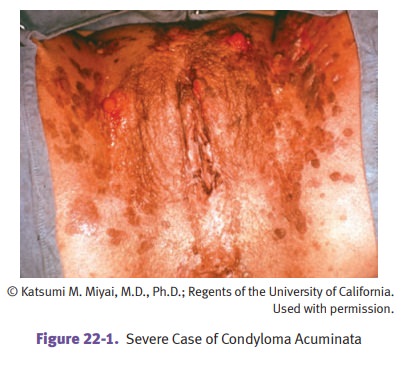Chapter: Pathology: Female Genital Pathology
Vulva - Pathology
VULVA
Non-Neoplastic Disorders
•
Lichen
sclerosis is caused by epidermal thinning and dermal changes which cause pale skin in postmenopausal women. There
is a small risk of progression to squamous cell carcinoma (SCC).
•
In lichen
simplex chronicus, a chronic scratch/itch cycle produces the white plaques seen
clinically. These plaques are characterized microscopically by squamous cell
hyperplasia and dermal inflammation.
Infections
•
Human
papillomavirus (HPV) causes warty lesions (condylomata acuminata) and precursor dysplastic lesions of squamous
cell carcinoma called vulvar intraepithelial neoplasia (VIN). Vulvar HPV is
commonly subtype 6 and 11 and therefore has low oncogenic potential.
•
Herpes
simplex virus (HSV). Most cases of vulvar herpes are caused by HSV-2. Painless vesicles progress to pustules and
painful ulcers.
•
Syphilis is a sexually transmitted disease caused by Treponema pallidum. The primary lesion is a chancre,
a painless ulcer that does not scar after healing.
•
Molluscum contagiosum is a viral disease caused by
a DNA poxvirus. It pres-ents as smooth papules and has characteristic
cytoplasmic viral inclusions.
•
Bartholin
gland abscess is a polymicrobial infection requiring drainage or excision.

Tumors
•
Papillary
hidradenoma is a benign tumor of modified apocrine sweat glands of the labia majora or interlabial folds. It
occurs along the milk line and may ulcerate, mimicking carcinoma. Papillary
hidradenoma is histologically simi-lar to an intraductal papilloma of the
breast.
•
Extramammary
Paget disease of the vulva usually involves the labia majora, and it causes an
erythematous, crusted rash that is characterized microscopi-cally by
intraepidermal malignant cells with pagetoid spread. This form of Paget disease
is not usually associated with underlying tumor.
•
Squamous
cell carcinoma is the most common malignancy of the vulva. The most common form occurs in women age >60.
The less common form occurs in younger women with HPV serotypes 16 and 18.
•
Melanoma
can
occur on the vulva, and must be differentiated from lentigo simplex which is more common.
Related Topics